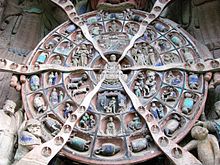Impermanence (Buddhism)
| Part of a series on |
| Buddhism |
|---|
  |
| Translations of Impermanence | |
|---|---|
| English | Impermanence |
| Sanskrit | अनित्य (IAST: anitya) |
| Pali | अनिच्च (anicca) |
| Burmese | အနိစ္စ (MLCTS: anicca) |
| Chinese | 無常 (Pinyin: wúcháng) |
| Japanese | 無常 (Rōmaji: mujō) |
| Khmer | អនិច្ចំ (UNGEGN: ânĭchchâm) |
| Korean | 무상 (RR: musang) |
| Tibetan | མི་རྟག་པ་ (Wylie: mi rtag pa, THL: mi tak pa) |
| Tagalog | anissa |
| Thai | อนิจจัง (RTGS: anitchang) |
| Vietnamese | vô thường |
| Glossary of Buddhism | |

Impermanence, called anicca (Pāli) or anitya (Sanskrit), appears extensively in the Pali Canon[1] as one of the essential doctrines of Buddhism.[1][2][3] The doctrine asserts that all of conditioned existence, without exception, is "transient, evanescent, inconstant".[1]
Anicca is one of the three marks of existence—the other two are dukkha (suffering or unsatisfactory) and anatta (without a lasting essence).
Anicca is in contrast to nirvana, the reality that is nicca, or knows no change, decay or death.[1]
In the marks of existence
[edit]Anicca is understood in Buddhism as the first of the three marks of existence (trilakshana), the other two being dukkha ('unease', from dushta, "standing unstable") and anatta (non-self, non-soul, no essence).[2][3][4][5] It appears in Pali texts as, "sabbe sankhara anicca, sabbe sankhara dukkha, sabbe dhamma anatta", which Szczurek translates as, "all conditioned things are impermanent, all conditioned things are painful, all dhammas are without Self".[6]
All physical and mental events, states Buddhism, come into being and dissolve.[1][7][8][9] Human life embodies this flux in the aging process, the cycle of repeated birth and death (Samsara), nothing lasts, and everything decays. This is applicable to all beings and their environs, including beings who have reincarnated in deva (god) and naraka (hell) realms.[10][11]
Everything, whether physical or mental, is a formation (Saṅkhāra), has a dependent origination and is impermanent. It arises, changes and disappears.[12][13] According to Buddhism, everything in human life, all objects, as well as all beings whether in heavenly or hellish or earthly realms in Buddhist cosmology, is always changing, inconstant, undergoes rebirth and redeath (Samsara).[10][11]
Association with anatta
[edit]Anicca is intimately associated with the doctrine of anatta, according to which things have no essence, permanent self, or unchanging soul.[14][15] Understanding Anicca and Anatta are steps in the Buddhist's spiritual progress toward enlightenment.[8][16][17]
Association with dukkha
[edit]Impermanence is a source of dukkha. The Buddha taught that because no physical or mental object is permanent, desires for or attachments to either causes suffering (dukkha).
Rupert Gethin on Four Noble Truths says:[18]
As long as there is attachment to things that are
unstable, unreliable, changing and impermanent,
there will be suffering –
when they change, when they cease to be
what we want them to be.
(...)
If craving is the cause of suffering, then the cessation
of suffering will surely follow from 'the complete
fading away and ceasing of that very craving':
its abandoning, relinquishing, releasing, letting go.
References
[edit]- ^ a b c d e Thomas William Rhys Davids; William Stede (1921). Pali-English Dictionary. Motilal Banarsidass. pp. 355, Article on Nicca. ISBN 978-81-208-1144-7.
- ^ a b Richard Gombrich (2006). Theravada Buddhism. Routledge. p. 47. ISBN 978-1-134-90352-8., Quote: "All phenomenal existence [in Buddhism] is said to have three interlocking characteristics: impermanence, suffering and lack of soul or essence."
- ^ a b Robert E. Buswell Jr.; Donald S. Lopez Jr. (2013). The Princeton Dictionary of Buddhism. Princeton University Press. pp. 42–43, 47, 581. ISBN 978-1-4008-4805-8.
- ^ Anatta Buddhism, Encyclopædia Britannica (2013);
- ^ Phra Payutto (1995). Buddhadhamma: Natural Laws and Values for Life. Translated by Grant Olson. State University of New York Press. pp. 62–63. ISBN 978-0-7914-2631-9.
- ^ Richard Francis Gombrich; Cristina Anna Scherrer-Schaub (2008). Buddhist Studies. Motilal Banarsidass. pp. 209–210. ISBN 978-81-208-3248-0.
- ^ Anicca Buddhism, Encyclopædia Britannica (2013)
- ^ a b Ray Billington (2002). Understanding Eastern Philosophy. Routledge. pp. 56–59. ISBN 978-1-134-79348-8.
- ^ Robert E. Buswell Jr.; Donald S. Lopez Jr. (2013). The Princeton Dictionary of Buddhism. Princeton University Press. pp. 47–48, Article on Anitya. ISBN 978-1-4008-4805-8.
- ^ a b Damien Keown (2013). Buddhism: A Very Short Introduction. Oxford University Press. pp. 32–38. ISBN 978-0-19-966383-5.
- ^ a b Peter Harvey (2012). An Introduction to Buddhism: Teachings, History and Practices. Cambridge University Press. pp. 32–33, 38–39, 46–49. ISBN 978-0-521-85942-4.
- ^ Paul Williams (2005). Buddhism: Buddhism in China, East Asia, and Japan. Routledge. pp. 150–153. ISBN 978-0-415-33234-7.
- ^ Damien Keown (2004). A Dictionary of Buddhism. Oxford University Press. p. 15. ISBN 978-0-19-157917-2.
- ^ Anatta Buddhism, Encyclopædia Britannica (2013)
- ^ [a] Christmas Humphreys (2012). Exploring Buddhism. Routledge. pp. 42–43. ISBN 978-1-136-22877-3.
[b] Brian Morris (2006). Religion and Anthropology: A Critical Introduction. Cambridge University Press. p. 51. ISBN 978-0-521-85241-8., Quote: "(...) anatta is the doctrine of non-self, and is an extreme empiricist doctrine that holds that the notion of an unchanging permanent self is a fiction and has no reality. According to Buddhist doctrine, the individual person consists of five skandhas or heaps - the body, feelings, perceptions, impulses and consciousness. The belief in a self or soul, over these five skandhas, is illusory and the cause of suffering."
[c] Richard Gombrich (2006). Theravada Buddhism. Routledge. p. 47. ISBN 978-1-134-90352-8., Quote: "(...) Buddha's teaching that beings have no soul, no abiding essence. This 'no-soul doctrine' (anatta-vada) he expounded in his second sermon." - ^ Brian Morris (2006). Religion and Anthropology: A Critical Introduction. Cambridge University Press. pp. 51–53. ISBN 978-0-521-85241-8.
- ^ John Whalen-Bridge (2011). Writing as Enlightenment: Buddhist American Literature into the Twenty-first Century. State University of New York Press. pp. 154–155. ISBN 978-1-4384-3921-1.
- ^ Rupert Gethin (1998). The Foundations of Buddhism. Oxford University Press. p. 74. ISBN 978-0-19-160671-7.
